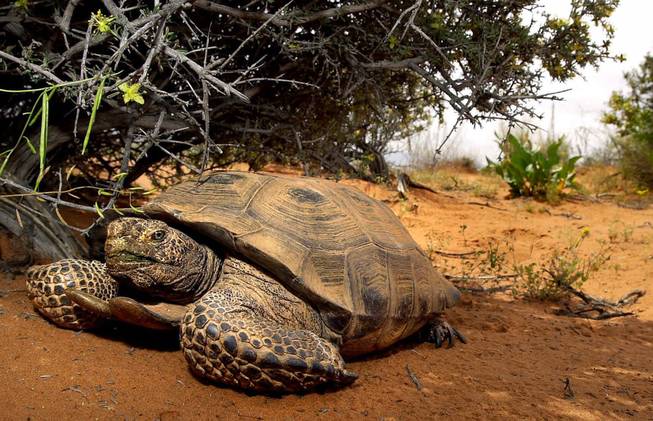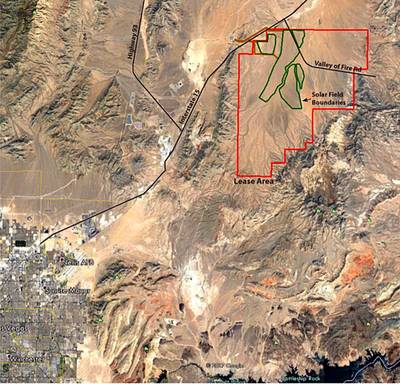
Douglas C. Pizac / AP
In this file photo, a desert tortoise like those found in Nevada seeks relief from the sun under a bush.
Tuesday, June 18, 2019 | 2 a.m.
The construction of a solar plant that would send power to Nevada, Arizona and California is receiving pushback from some environmental groups.
The Gemini Solar Project would be the largest solar array in the country, generating 690 megawatts of electricity across 7,100 acres in the Mojave Desert just south of the Moapa River Indian Reservation. It’s about 30 miles northeast of Las Vegas.
While some believe the project is a positive step in the development of green energy, others see flaws. Basin and Range Watch, for instance, criticized the project’s threat on rare plants and endangered species.
“The area is not only important to wildlife and biodiversity, it’s also a popular recreational spot,” said Kevin Emmerich, the Basin and Range Watch leader.
Emmerich also said the project would damage the habitat of the desert tortoise population.
Bureau of Land Management, who earlier this month completed a draft of an environmental impact statement for the proposal, calls for maintaining a large chunk of the tortoise environment and reintroducing them after the construction of the solar arrays.
But Emmerich said reintroducing desert tortoises to a habitat comes with its own problems.
“Disoriented tortoises often get killed by savvy predators like coyotes,” he said. “Tortoises also try to get back to their original (habitat) and they’ll get stressed, overheat and die.”
Kobbe Shaw, of the Nevada-based nonprofit Tortoise Group, said any massive development would affect the tortoise population.
But disrupting the species’ habitat for a renewable energy project is still better than a home subdivision, he said.
“From a conservation standpoint, we want to make sure as much tortoise habitat remains and doesn’t get messed with,” he said. “To be perfectly honest in the long run, something like renewable energy should be looked at in a holistic sense and what’s best for conservation itself.”
When it comes to conservation as a whole, Shaw said he is looking at the greater good for the environment and not just desert tortoise.
“Without a broader effort for conservation in the Mojave, just looking at the desert tortoise is rearranging deck chairs on the Titanic,” he said.
Emmerich said he isn’t against green projects, just projects like Gemini with environmental ramifications. He suggested alternatives like rooftop solar arrays or building solar plants on old stripped mining sites.
“Using undeveloped public land should be a last resort,” he said.
The project would generate approximately 2,000 direct jobs during peak construction and create seven permanent staff jobs after the facility is completed, according to the BLM.
UNLV professor Bob Bohem has worked on several solar projects over the last three decades. He said what makes the Gemini project significant is not just its size, but its plans to incorporate battery storage. The project is slated to have one of the world’s largest battery systems.
“Battery storage has been a goal all along,” he said.
Battery storage capabilities mean that the plant will still generate energy, even when the sun isn’t shining, Bohem said.
The BLM’s environmental draft was released June 7 to open a 90-day public comment period that will end Sept. 5. Public meetings are scheduled July 23 at the Suncoast and July 24 at the Moapa Community Center.
“The statements are designed to let the public know the issues we have found to let them know upfront and the constraints that this project may have,” said Herman Pinales, the project manager for BLM Southern Nevada District, Energy & Infrastructure. “It gives the public the opportunity to look at it and get the best information.”

